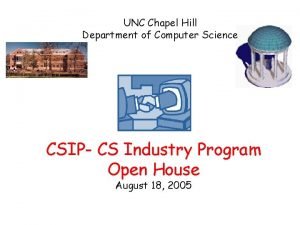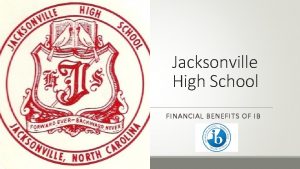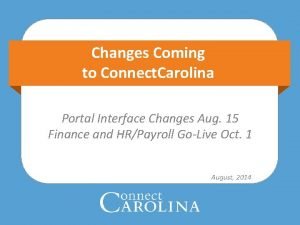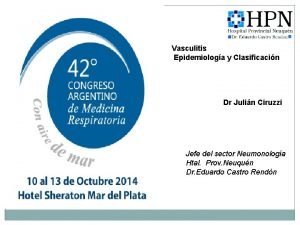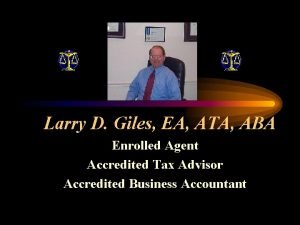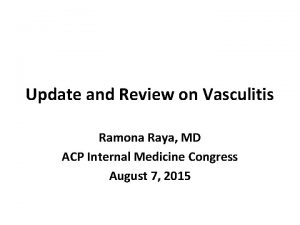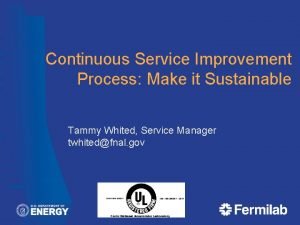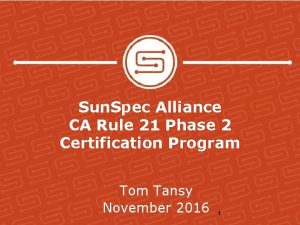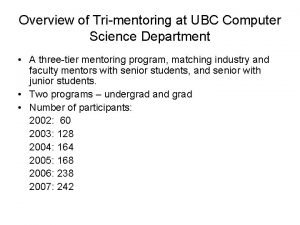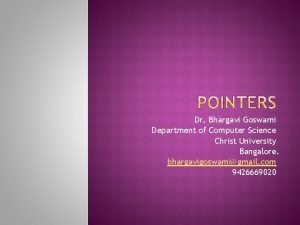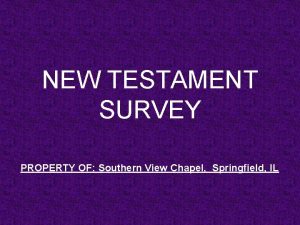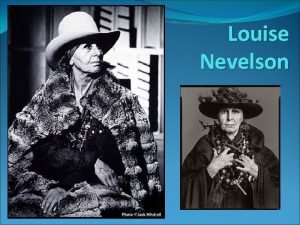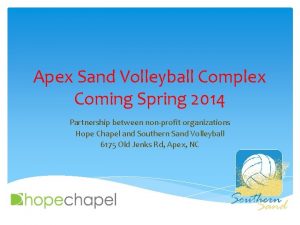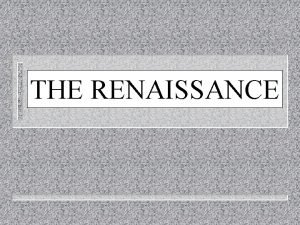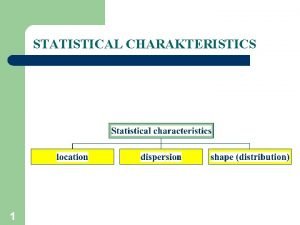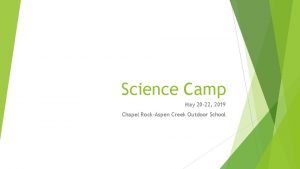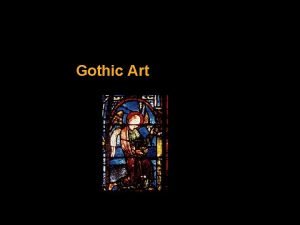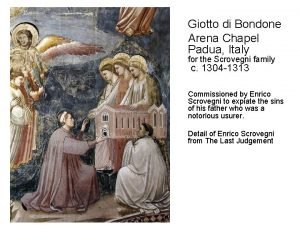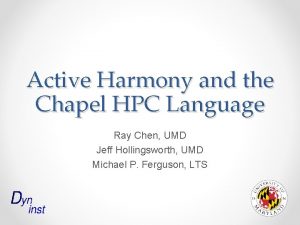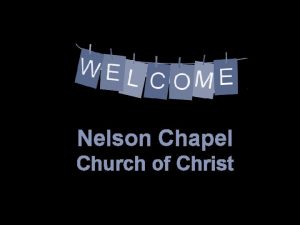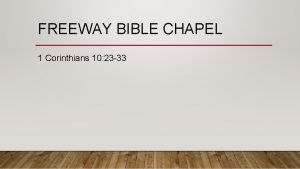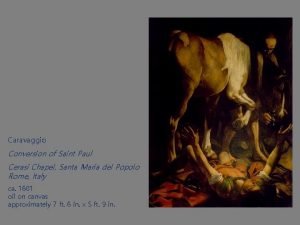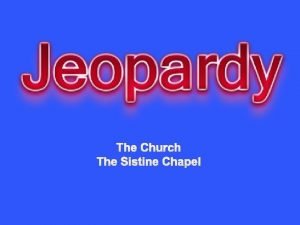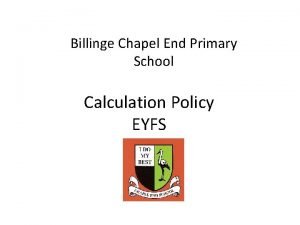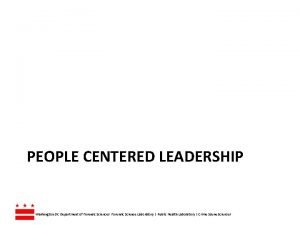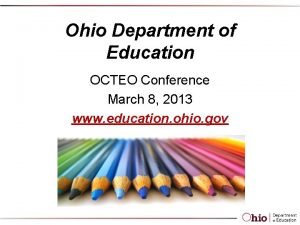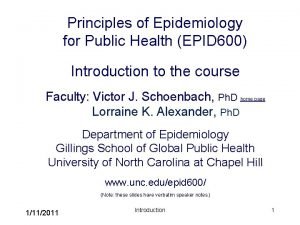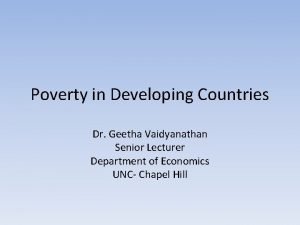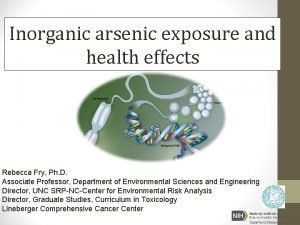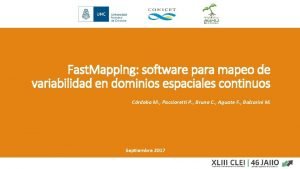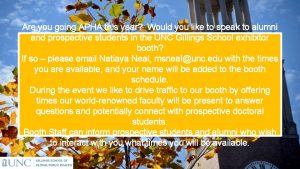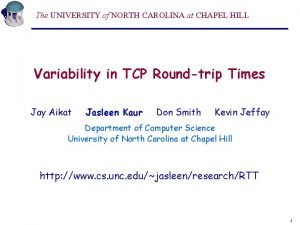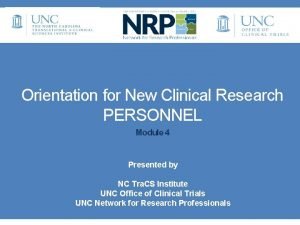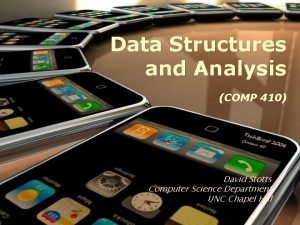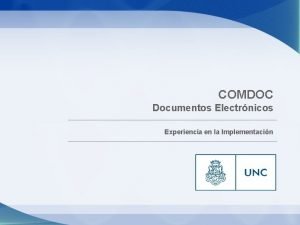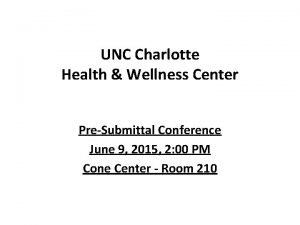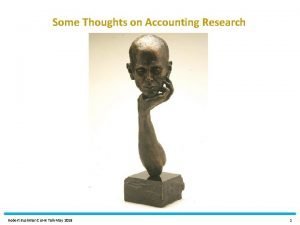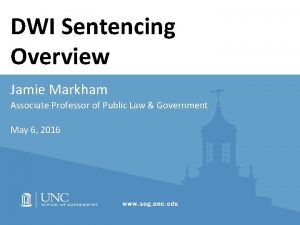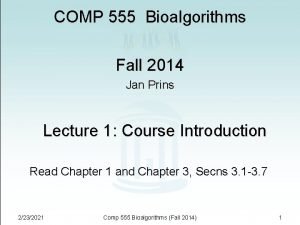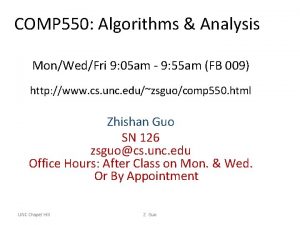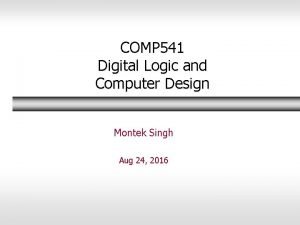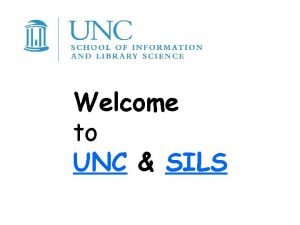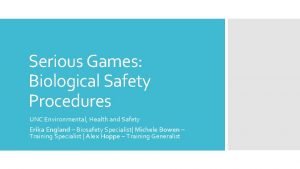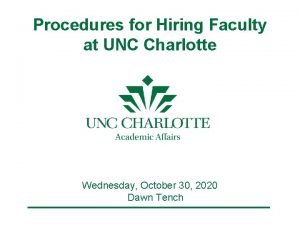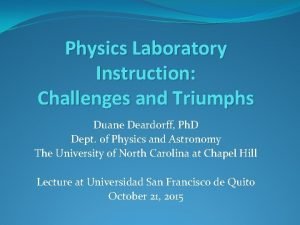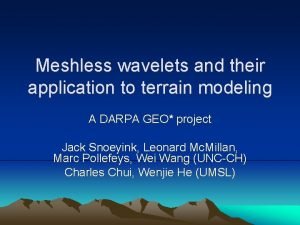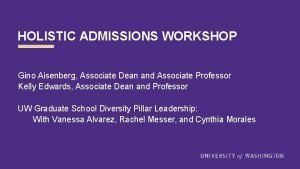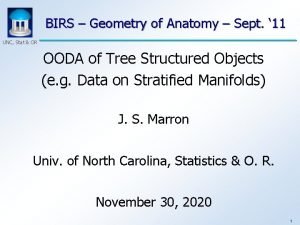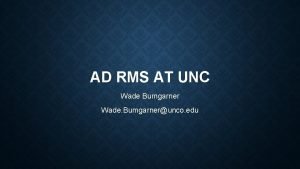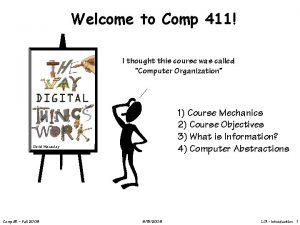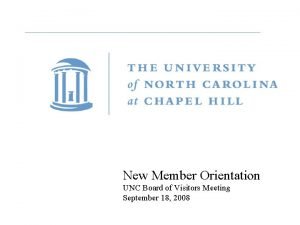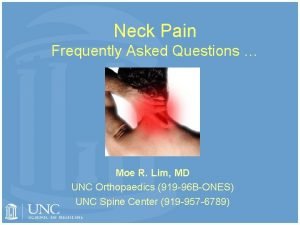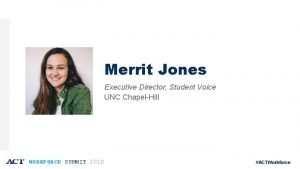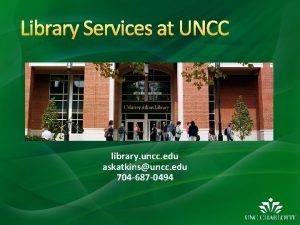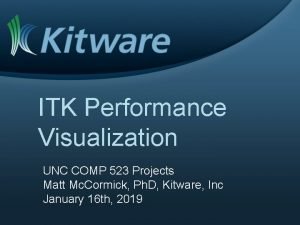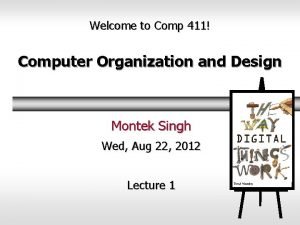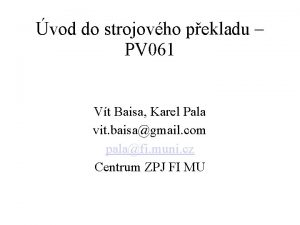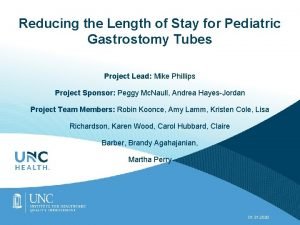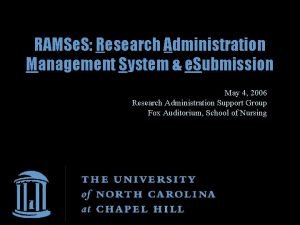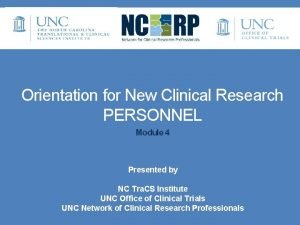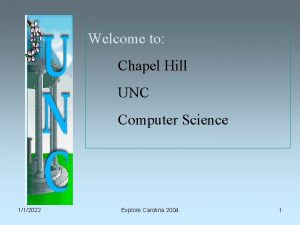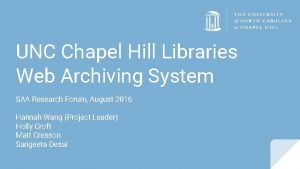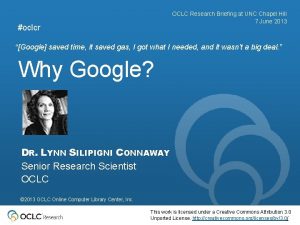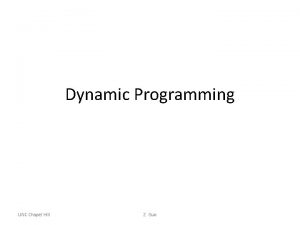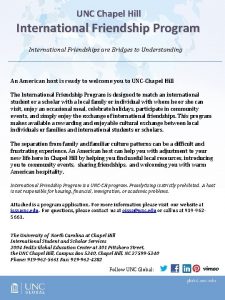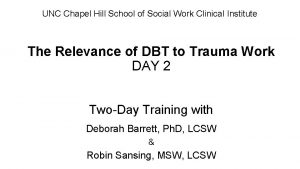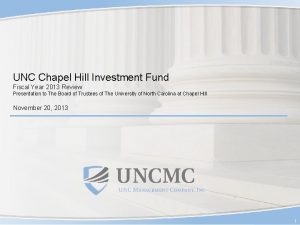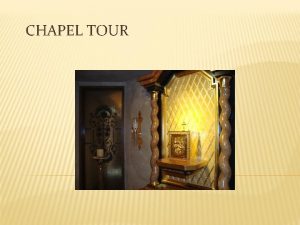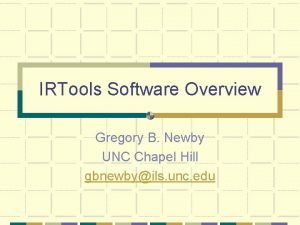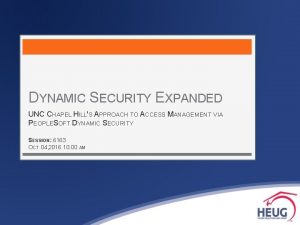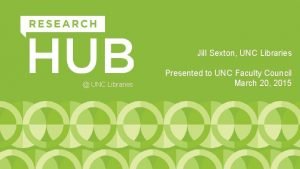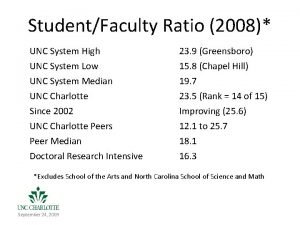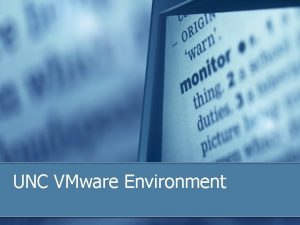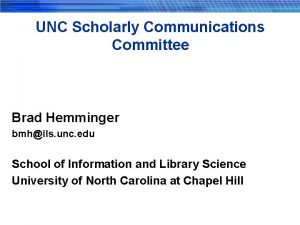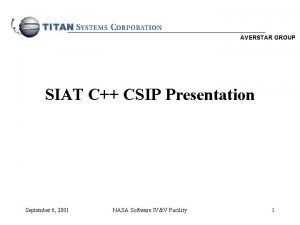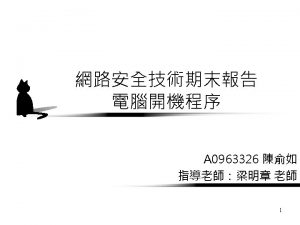UNC Chapel Hill Department of Computer Science CSIP









































































![Need for Real World Exposure [Computer science] spans both advancing the fundamental understanding of Need for Real World Exposure [Computer science] spans both advancing the fundamental understanding of](https://slidetodoc.com/presentation_image_h/19f1c2389742ea826238937014e3f09a/image-74.jpg)


- Slides: 76

UNC Chapel Hill Department of Computer Science CSIP- CS Industry Program Open House August 18, 2005

Welcome! q Purpose q Agenda Ø Overview of the department (Jan Prins, chair) Ø Computer Scientist as toolsmith (Fred Brooks, founder) Ø Working with the Department (Tim Quigg, assoc chair) Ø Undergraduate Program (Diane Pozefsky, CSIP pgm mgr) Ø Graduate Program (Anselmo Lastra, dir grad studies) Ø Technology Transfer (Nick England, pres 3 rd Tech) Ø Collaboration (Russ Taylor, assoc prof) Ø Outreach (Gary Bishop, prof) Ø CSIP – our new industrial partners program (Diane Pozefsky) Ø Discussion q Presentations will be available on www. cs. unc. edu/csip 2

Computer Science at UNC q History Ø one of the first Computer Science departments in the nation Ø founded by Fred Brooks in 1965 q Now ranked among top-20 CS research departments in the US q Degree programs Ø M. Sc. and Ph. D. program (since 1965) ― currently about 150 - 170 students ― interdisciplinary training programs Ø B. Sc. program (since 2001) ― currently ― also § § § about 50 - 100 students B. S. honors program B. S. minor in Computer Science B. A. Computer Science (under development) 3

Research Philosophy q Strive for critical mass within the department to create peaks of excellence Ø about 25 tenure track faculty and 5 research faculty Ø top ranked graphics program in the country q Work on real driving problems whose solution does some good q Collaborate with others outside Computer Science 4

Educational Themes q Focus on principles, but closely track technology q Immersion q Collaboration q Learning by doing q Writing q Teaching 5

Department Funding UNC-CH COMPUTER SCIENCE DEPARTMENT BUDGET FOR SFY 2004 -2005 TOTAL* $14. 1 M *Total does not include equipment and software donations 6

HCI, augmented reality, virtual environments 7

3 D Image acquisition and rendering 8

Medical Image Display and Analysis 9

Collaboration Technology 10

Computer-based Assistive Technologies 11

Computational Biology & Bioinformatics 12

Networking Research 13

Summary: Principal Research Areas q Augmented and virtual environments (Brooks, Fuchs, Welch, Whitton) q Ø 3 D surgery, office-of-the-future, training Ø internet performance analysis, mobile environments, psychophysical research q Medical image processing (Gerig, Pizer) Ø parametric descriptions of shape, brain computing, multimedia q atlas, acquisition and display q Computer graphics (Fuchs, Lastra, Mc. Millan) Ø global illumination, hardware systems q Computer vision (Fuchs, Mc. Millan, Pollefeys) Ø 3 D structure from multiple cameras, video, Human-computer interfaces (Lin, Manocha, Taylor, Welch) parallel computing q q q programming Computational geometry (Pollefeys, Snoeyink) Ø GIS, theory q Real-time systems (Anderson, Baruah) q Assistive technologies (Bishop, Weiss) q Web-based computing (Pozefsky, JB Smith) Collaboration Technology (Dewan, Stotts) Ø collaboration architectures, pair- Bioinformatics and Computational Biology (Prins, Snoeyink, Wang) Ø data mining, protein modeling Ø nanoscale microscopy, 3 D modeling, stereo and haptics, projector enhanced offices High-performance computing (Manocha, Prins, Reed, Taylor) Ø scientific computing, GPU-based computing, high-speed range-finders q Networking (Kaur, Jeffay, Mayer-Patel, Papadopouli, FD Smith) Ø scheduling theory, real-time applications Ø education, navigation, interfaces Ø Service architecture, curriculum development 14

The Computer Scientist as Toolsmith Fred Brooks University of North Carolina at Chapel Hill www. cs. unc. edu/~brooks CACM, (March, 1996), 39(3): 61 -68. 15

A Discipline Misnamed q Computer science is not a science; science is the discovery of properties of nature. 16

q It is a synthetic discipline; we make things: Øcomputers Øalgorithms Øoperating systems Øapplication programs Øproofs 17

q q By and large, the things we make do not directly satisfy human needs. We make chiefly tools, which others use in making things that enrich human living. 18

We can measure our success only by the success of our users. 19

The “Computer” Part is So Right! q q q Only the computer’s rich powers justify our making of complex tools. Only the computer could enable us to make things of such subtlety and complexity. It was, after all, the “Association for Computing Machinery. ” 20

Intelligence Amplification Thesis: IA > AI At any given stage in technology, one can solve harder problems with a machine + a mind than with a machine alone. 23

Mind-Machine Communication The hardest part is the last four inches. 24

Mind-Machine Systems q q Eyes give broadest bandwidth in, hence computer graphics. Hearing and feeling carry yet different information; we need them all. Speaking is the way for commands. Pointing and moving are the ways to specify nouns and adverbs. 25

Can We Do Anything Useful? Thesis: Hitching our research to someone else’s driving problems, and solving those problems on the owners’ terms, leads us to richer computer science research. (The Down-is-Up paradox) 26

The Driving Problem Approach q Aims us at relevant problems, not toys. q Keeps us honest about success and failure. q Makes us face the whole problem, not just the easy or mathematical parts. q Forces us to new computer science. q What fun! 27

Virtual Reality Driving Problems q Radiation Treatment Planning q X-ray Vision for Surgery q Protein Structure q Scanning Probe Microscope Control q Building and Ship Design q Training Marines for Urban Warfare 28

Costs of Collaboration q q q Collaborator-support routine work— 25% “I need a picture for this paper. ” Collaboration maintenance time — only the boss can do it. Learning another discipline (somewhat). 29

A Special Case of the Law of Life He who would hoard his time, knowledge, and skills for himself will lose them; but he who will give them to others will find them enhanced. 30

Working with the Department Tim Quigg 31

How to Work With the Department There are many ways! q Technology Licensing q Sponsored Research q Targeted Gifts q Student Fellowships q You Tell Us q CSIP 32

Who to Contact in the Department q Tim Quigg, Associate Chair 962 -1777, quigg@cs. unc. edu q Diane Pozefsky, Research Professor 962 -1817, pozefsky@cs. unc. edu 33

34

Undergraduate Program Diane Pozefsky 35

Our Students q UNC attracts the top students in the UNC system Ø Most come in with large number of advanced credits, allowing for flexibility q Our department has among the most stringent requirements for acceptance as a major Ø 4 math, 2 physics, 3 comp sci courses – with minimum grade of C q Our graduates go on to business and further education Ø Startups and large companies and everything in between Ø We have sent students to all of the major CS programs q This past year Ø Microsoft, Nortel, Amazon Ø CMU, Columbia, Stanford Law 36

CS in A Liberal Arts School q Our students don’t declare their major until end of sophomore year ØBUT, we start advising them as soon as they tell us they’re interested q Requirement for breadth of courses ØOpportunity to study other fields ØAllows us to advise and direct 37

What Do We Teach? q We focus on the underlying concepts rather than specific technologies Ø Technologies will change, fundamentals won’t Ø Require a breadth of topics ― Theory ― Systems ― Programming ― Applications languages ― Interdisciplinary q q Strongly encourage (may soon require) a significant project course In many courses, competing with graduate students as well 38

Where are we headed? q Degree offerings Ø Today: Bachelor of Science, minor Ø Planning: Bachelor of Arts – specifically being designed to encourage interdisciplinary study Ø Future consideration: 5 -year Bachelor/Master q Interdisciplinary cooperation Ø Currently working on a technology ethics course Ø Others discussed ― Physics for the computer ― Business courses ― Arts (music, art) q scientist Targeting co-op program for ’ 06 Ø 2 -rotation: spring/summer or summer/fall Ø Most students will still be able to graduate in 4 years Ø Provides a 7 -8 month experience 39

The Graduate Program Anselmo Lastra Director of Graduate Studies 40

Overview of the Program q Almost 200 graduate students Ø 49 coming in this Fall ØGRE scores above 90 th percentile quantitative and analytical; close to that verbal ØUndergrad GPAs above 3. 5/4. 0 q We do not differentiate between MS and Ph. D during admission 41

Characteristics of the Program q q Research intensive Program Product requirement for all graduates, MS and Ph. D ØLarge program, documented, with specifications ØCOMP 145 – group projects with client 42

Internships q Most of our students do at least one internship ØSome for extended periods if it benefits their research q We encourage this, especially the first summer of grad school 43

Possible Plans q Professional Masters program ØMost likely oriented to part-time students, evening classes q Perhaps other professional training q We’d like to talk to you about this ØDiscuss what types of programs would be useful to local industry ØGauge interest 44

Technology Transfer at Carolina: Issues and Opportunities Tim Quigg, Assoc Chair Nick England, 3 rd Tech 45

Goals of OTD q q q Manage UNC’s intellectual property assets; Protect and serve rights and interests of university and its faculty; Facilitate the passage of research innovations into the marketplace for the public good; Generate a growing source of funds to support the university, its faculty and the research enterprise; and Connect the university to economic development. 46

Policy Framework q Bayh-Dole Act (1980) q UNC Patent and Copyright Policy q UNC-CH Patent and Copyright Procedures q UNC System Conflict of Interest/Commitment Policy q IRS and related regulations 47

OTD Licensing Strategies q q Market to / partner with existing companies Typically convey patent rights in return for research support, royalties, patent costs, etc. Diligence, field of use, related terms ensure maximum technology deployment Effective way to build partnerships, transfer technology - will always be bread and butter 48

Start-Ups/Faculty Entrepreneurs q q License remains tech transfer mechanism University / faculty entrepreneur create new company to commercialize technology q Equity provided to university & inventor(s) q Faculty often involved as consultants/advisors q OTD helps develop business plan, locate venture capital, recruit management, find space 49

50

Current OTD highlights q q q 7 professional project managers (5 Ph. Ds, 2 MBAs, patent attorney, 20 years industry experience, 48+ years tech transfer experience) 24 companies in 5 years; > 281 jobs 3 x increase in license revenue between FY 02 and FY 04 ($3. 9 M in FY 04); large stock portfolio Extensive campus and community outreach / education / partnership Campus, regional, national leadership position Major role w/ Carolina North planning, economic development initiatives 51

Office of Technology Development Mark Crowell Associate Vice Chancellor for Economic Development 962 -4041 mark_crowell@unc. edu 52

db. Tag Division Nano. Manipulator delta. Sphere Pixel. Fusion UNC-CH Computer Science Department Intellectual Property Ivex Inner. Optics Tech Highball Tracker Morphormics Elumens 53

Collaborative Opportunities Russ Taylor 54

Computer Science Outreach Enabling Technology Gary Bishop 55

Two types of Outreach q q Increase the pipeline of students in CS Give our students real-world experience while helping the broader community 56

CS Pipeline q K-12: CS and Science Ø Visits for existing programs IBM EXITE camp for middle school girls Mentoring programs NCSU CESE camp for rising high school seniors Ø Support for Engineering Week: host NC Coalition web site ― ― ― q University Ø Broad range of courses Power Tools for the Mind Computers and Society Introductory Programming First Year Seminars Ø Active recruitment of students Ø Sponsor undergraduate club ― ― 57

Comp 145: Software engineering lab q q q Other departments (e. g. , archaeology, radiology) Partnership for Minority Advancement in the Biomolecular Sciences Piedmont Wildlife Center TOP-CAT (Durham technology access for under served neighborhoods) Literacy Web Site 58

Enabling Technology Projects q Blind Ø Ø Ø q Blind Audio Tactile Mapping System Hark the Sound Mazes / Navigation / Spatial listening Accessible i. Tunes Audio RPG Switch users Ø Web access Ø Literacy q Augmented communication 59

Blind Audio Tactile Maps q Text-to-speech q 3 D sound q Audio icons q Tactile feedback 60

Hark the Sound What do children who are blind do while their classmates go to computer lab? Nothing! 61

Hark the Sound (of Tar Heel Voices) q A sound game for kids Ø Name that Animal, Musical Instrument Ø Name that Tune (Kids, Classical, Country, Rock) Ø State Capitals, Nick Names Ø Braille Letters and Contractions Ø Arithmetic 62

Hark the Sound in use 63

Hark the Sound in use 64

Braille Twister & Whack-It 65

Sonic Zoom 66

Descent into Madness! 67

Switch Accessible Browsing 68

Switch Typing in a Browser 69

What’s next? q Literacy tools q Augmented communication q Dance Revolution q Recording spatial audio q WYSIWYG Accessibility 70

CSIP Diane Pozefsky 71

What is CSIP? q Program to build partnerships ØBidirectional benefits ØGoal is to create good neighbors ― Get to know each other ― Help each other ― Learn from each other q Not a fundraising initiative ØBut we do hope to build relationships that may raise money 72

Specific Goals q Improved curriculum q Improved career pipeline q Improved research collaboration ØCoverage ØDose of reality ØExperiential opportunities ØBest jobs for best students ØBetter opportunities during economic slow times ØKeeping our best in North Carolina ØBy learning what is going on ØBy making connections 73

Computer Science Curriculum has not Changed with the Industry q Growth of the services sector q Need for enhanced usability q Assembling systems rather than building q Focus on customer and business components q Developing for the bazaar rather than the cathedral q Question: What do we incorporate in the CS curriculum? 74

Curriculum Changes q Changes come in two directions: From practice ― Practices precede the underlying theory ― What to teach? ― Example: web technologies From research ― Gambling on value ― Will it be applicable? ― Example: artificial intelligence 75
![Need for Real World Exposure Computer science spans both advancing the fundamental understanding of Need for Real World Exposure [Computer science] spans both advancing the fundamental understanding of](https://slidetodoc.com/presentation_image_h/19f1c2389742ea826238937014e3f09a/image-74.jpg)
Need for Real World Exposure [Computer science] spans both advancing the fundamental understanding of algorithms and information processes in general as well as the practical design of efficient reliable software and hardware to meet given specifications (CSAB) q Computer science is both theory and engineering Øto properly teach students, they need to understand practice as well as theory q Two aspects ØApplicability introduced in the classroom ØField experience 76

Field Experience q Local industry is not seeing our best students ØDisbursed nationwide for summer ØTake jobs that “happen” ―Often not related to computer science § e. g. , based on high school connections ―Often at the university ØSeen as not having “real” experience 77

Making Research Connections q Not all research has connections to practice ØUnaware of potential uses ØDifference between hypothesizing and knowing q Making the connections ØFor researcher, improves the research ØFor practitioner, provides insights to new ideas 78
 University of north carolina chapel hill computer science
University of north carolina chapel hill computer science Unc hematology and oncology
Unc hematology and oncology Ohre unc
Ohre unc Unc chapel hill ib credit
Unc chapel hill ib credit Conect carolina
Conect carolina Consenso de chapel hill
Consenso de chapel hill Enrolled agent chapel hill, nc
Enrolled agent chapel hill, nc Clasificacion chapel hill vasculitis 2012
Clasificacion chapel hill vasculitis 2012 Csip definition
Csip definition Common smart inverter profile csip
Common smart inverter profile csip Ucl computer science faculty
Ucl computer science faculty Northwestern computer science department
Northwestern computer science department Computer science department rutgers
Computer science department rutgers Computer science department stanford
Computer science department stanford Florida state university cs faculty
Florida state university cs faculty Trimentoring
Trimentoring Department of computer science christ
Department of computer science christ Webnis
Webnis Maths is my favourite subject
Maths is my favourite subject Comparison of the four gospels chart
Comparison of the four gospels chart Louise nevelson dawn's wedding feast
Louise nevelson dawn's wedding feast Hope chapel apex
Hope chapel apex The baptistery of st. john
The baptistery of st. john Charakteristics
Charakteristics Chapel rock camp
Chapel rock camp Mixed woodland map symbol
Mixed woodland map symbol Ambulatory and radiating chapels
Ambulatory and radiating chapels Giotto di bondone arena chapel
Giotto di bondone arena chapel Chapel hpc
Chapel hpc Nelson chapel church of christ
Nelson chapel church of christ 1 corinthian 10 23
1 corinthian 10 23 Paris, a rainy day
Paris, a rainy day Wesley chapel high school
Wesley chapel high school Location of the sistine chapel
Location of the sistine chapel Chapel end primary school
Chapel end primary school Department of forensic science dc
Department of forensic science dc Oh.nesinc
Oh.nesinc Kerberos iitd
Kerberos iitd Nbse grading system
Nbse grading system Epid 600 unc
Epid 600 unc Dr geetha koushik
Dr geetha koushik Rebecca fry unc
Rebecca fry unc Fast mapping unc
Fast mapping unc Kenan flagler resume template
Kenan flagler resume template Kavita singh unc
Kavita singh unc Unc salary bands
Unc salary bands Jasleen kaur unc
Jasleen kaur unc Crms unc
Crms unc David stotts unc
David stotts unc Comdoc unc
Comdoc unc Uncc wellness center
Uncc wellness center Uncc transfer requirements
Uncc transfer requirements Cuhk exchange composite score
Cuhk exchange composite score 24 months in days
24 months in days Comp 555 unc
Comp 555 unc Monwedfri
Monwedfri Unc comp 541
Unc comp 541 Unc sils courses
Unc sils courses Fordham hall unc
Fordham hall unc Uncc isso
Uncc isso Duane deardorff unc
Duane deardorff unc Unc
Unc Unc
Unc Unc
Unc Unc active directory
Unc active directory I
I Unc shareware
Unc shareware Unc board of visitors
Unc board of visitors Moe lim unc
Moe lim unc Steve jones unc
Steve jones unc Uncc library login
Uncc library login Comp 523 unc
Comp 523 unc Comp 411
Comp 411 Vt vs unc
Vt vs unc Unc ihqi
Unc ihqi Andy johns unc
Andy johns unc Joy bryde unc
Joy bryde unc
